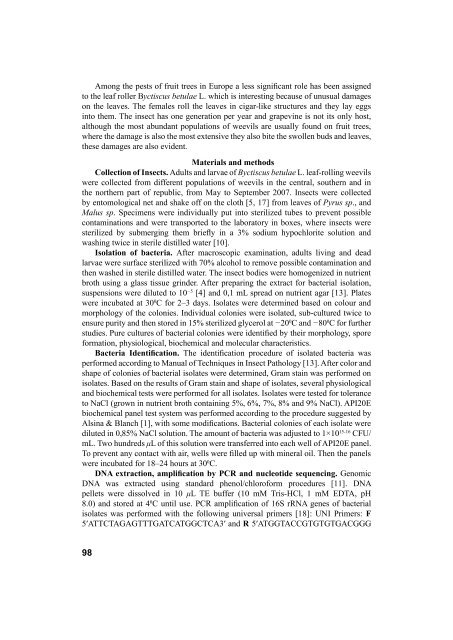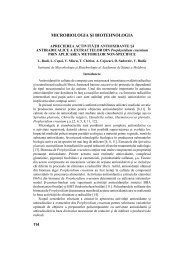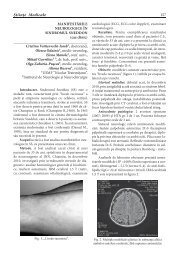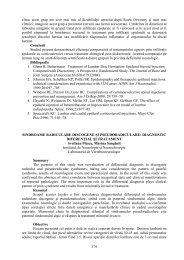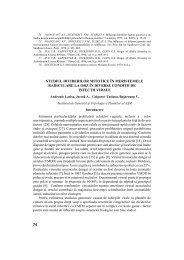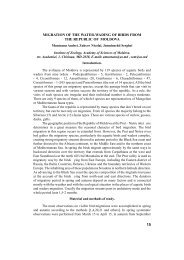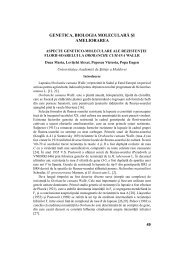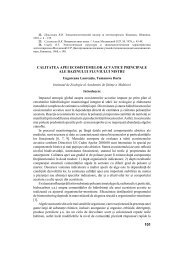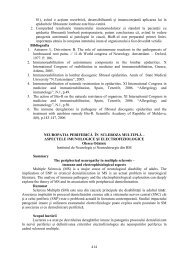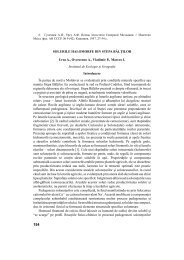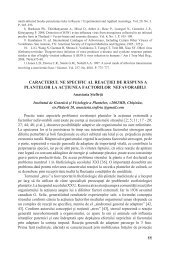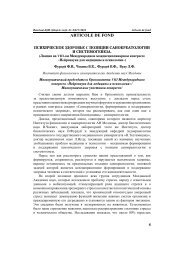198 CUPRINS
198 CUPRINS
198 CUPRINS
You also want an ePaper? Increase the reach of your titles
YUMPU automatically turns print PDFs into web optimized ePapers that Google loves.
Among the pests of fruit trees in Europe a less signi cant role has been assigned<br />
to the leaf roller Byctiscus betulae L. which is interesting because of unusual damages<br />
on the leaves. The females roll the leaves in cigar-like structures and they lay eggs<br />
into them. The insect has one generation per year and grapevine is not its only host,<br />
although the most abundant populations of weevils are usually found on fruit trees,<br />
where the damage is also the most extensive they also bite the swollen buds and leaves,<br />
these damages are also evident.<br />
Materials and methods<br />
Collection of Insects. Adults and larvae of Byctiscus betulae L. leaf-rolling weevils<br />
were collected from different populations of weevils in the central, southern and in<br />
the northern part of republic, from May to September 2007. Insects were collected<br />
by entomological net and shake off on the cloth [5, 17] from leaves of Pyrus sp., and<br />
Malus sp. Specimens were individually put into sterilized tubes to prevent possible<br />
contaminations and were transported to the laboratory in boxes, where insects were<br />
sterilized by submerging them brie y in a 3% sodium hypochlorite solution and<br />
washing twice in sterile distilled water [10].<br />
Isolation of bacteria. After macroscopic examination, adults living and dead<br />
larvae were surface sterilized with 70% alcohol to remove possible contamination and<br />
then washed in sterile distilled water. The insect bodies were homogenized in nutrient<br />
broth using a glass tissue grinder. After preparing the extract for bacterial isolation,<br />
suspensions were diluted to 10 −5 [4] and 0,1 mL spread on nutrient agar [13]. Plates<br />
were incubated at 30 0 C for 2–3 days. Isolates were determined based on colour and<br />
morphology of the colonies. Individual colonies were isolated, sub-cultured twice to<br />
ensure purity and then stored in 15% sterilized glycerol at −20 0 C and −80 0 C for further<br />
studies. Pure cultures of bacterial colonies were identi ed by their morphology, spore<br />
formation, physiological, biochemical and molecular characteristics.<br />
Bacteria Identi cation. The identi cation procedure of isolated bacteria was<br />
performed according to Manual of Techniques in Insect Pathology [13]. After color and<br />
shape of colonies of bacterial isolates were determined, Gram stain was performed on<br />
isolates. Based on the results of Gram stain and shape of isolates, several physiological<br />
and biochemical tests were performed for all isolates. Isolates were tested for tolerance<br />
to NaCl (grown in nutrient broth containing 5%, 6%, 7%, 8% and 9% NaCl). API20E<br />
biochemical panel test system was performed according to the procedure suggested by<br />
Alsina & Blanch [1], with some modi cations. Bacterial colonies of each isolate were<br />
diluted in 0,85% NaCl solution. The amount of bacteria was adjusted to 1×10 15-16 CFU/<br />
mL. Two hundreds μL of this solution were transferred into each well of API20E panel.<br />
To prevent any contact with air, wells were lled up with mineral oil. Then the panels<br />
were incubated for 18–24 hours at 30 0 C.<br />
DNA extraction, ampli cation by PCR and nucleotide sequencing. Genomic<br />
DNA was extracted using standard phenol/chloroform procedures [11]. DNA<br />
pellets were dissolved in 10 μL TE buffer (10 mM Tris-HCl, 1 mM EDTA, pH<br />
8.0) and stored at 4 0 C until use. PCR ampli cation of 16S rRNA genes of bacterial<br />
isolates was performed with the following universal primers [18]: UNI Primers: F<br />
5′ATTCTAGAGTTTGATCATGGCTCA3′ and R 5′ATGGTACCGTGTGTGACGGG<br />
98


